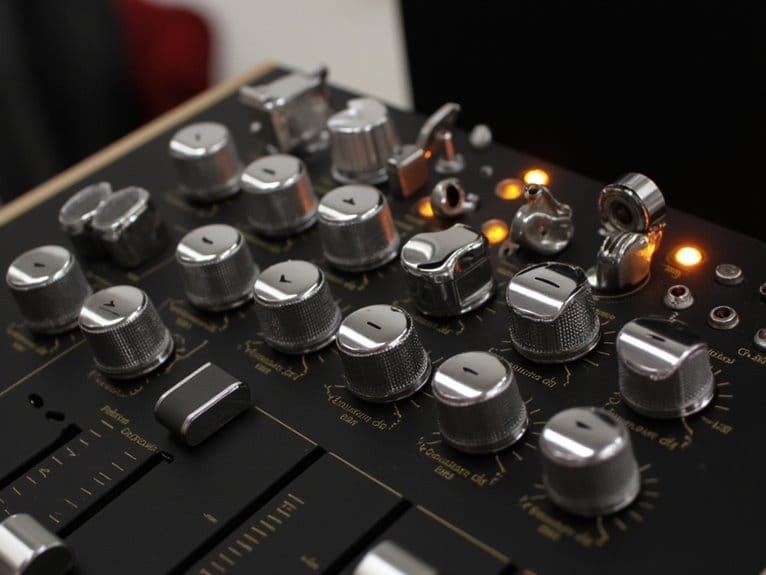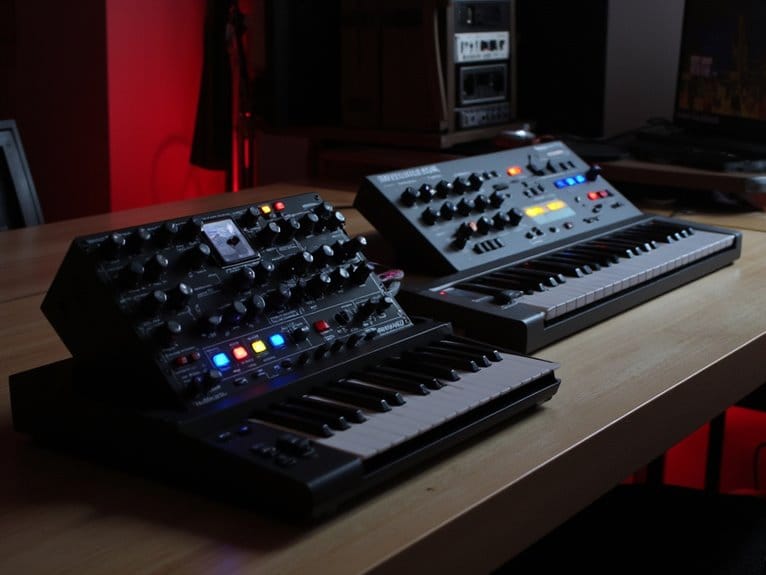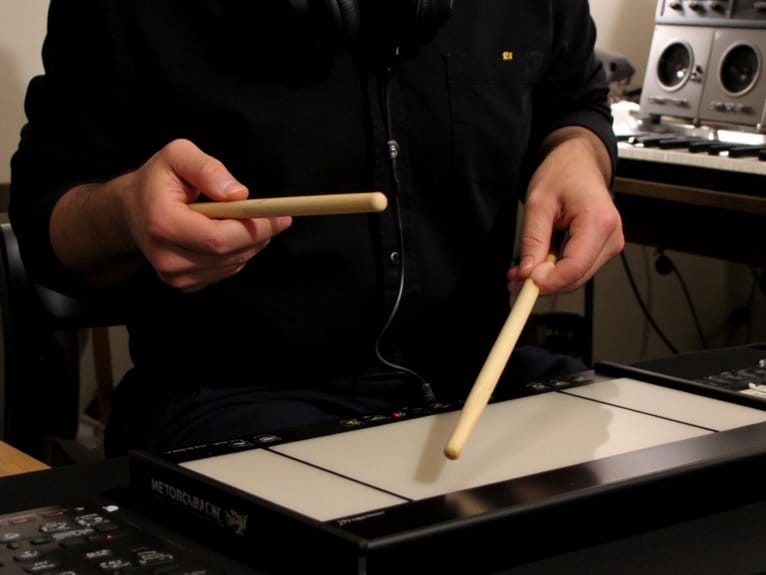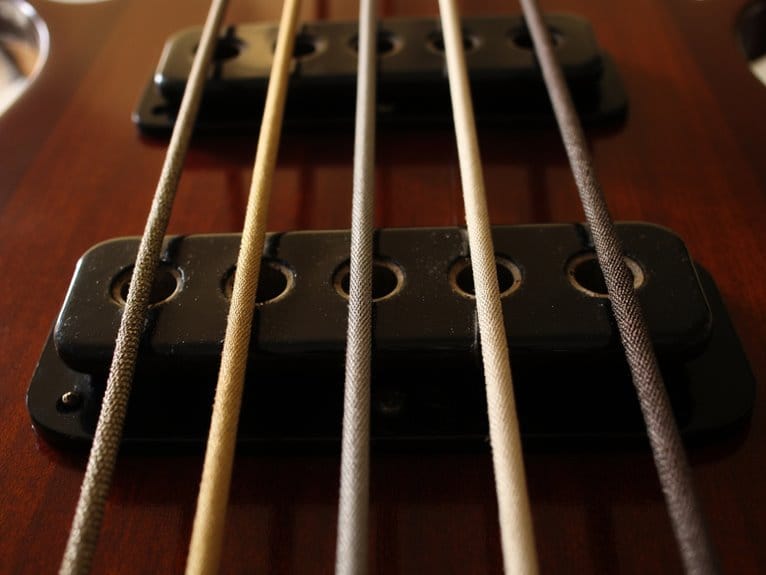Multiband Compression: Surgical Dynamic Control
Multiband compression splits your audio into separate frequency bands, allowing you to apply different compression settings to each range through sophisticated crossover networks that maintain phase alignment. You’ll gain surgical control over dynamics, compressing aggressive low-end while preserving delicate high frequencies, making it invaluable for vocal processing, drum bus enhancement, and mastering applications. However, conservative ratios and proper crossover settings prevent the tonal imbalances that transform this precision tool into a mix-destroying nightmare, and understanding these nuances reveals professional-grade results.
We are supported by our audience. When you purchase through links on our site, we may earn an affiliate commission, at no extra cost for you. Learn more.
Notable Insights
- Multiband compression divides audio into separate frequency bands, allowing independent compression settings for surgical frequency-specific control.
- Each band has dedicated threshold, ratio, attack, release, and knee controls for precise dynamic adjustments without affecting other frequencies.
- Essential for vocal mixing, drum transient shaping, and mastering applications requiring transparent frequency-targeted corrections.
- Conservative compression ratios and proper crossover settings prevent phase issues and maintain audio clarity across all frequency ranges.
- Use sparingly for surgical corrections rather than general fixing to preserve dynamic range and prevent over-compression artifacts.
Understanding the Architecture and Core Components
The foundation of multiband compression lies in its sophisticated crossover network, which I consider the most critical component that separates this technology from traditional single-band compression.
The crossover network’s sophisticated design stands as the defining element that elevates multiband compression beyond conventional single-band processing capabilities.
You’re fundamentally getting multiple independent compressors, each handling specific frequency ranges through carefully designed crossover points at frequencies like 200 Hz and 2 kHz. The crossover design determines how cleanly your audio gets divided, using gentle roll-offs instead of harsh brick-wall filtering to maintain transparency.
Each band gets its own dedicated compressor with complete control over threshold, ratio, attack, release, and knee settings, giving you surgical control over band dynamics.
After processing, all bands get recombined through summing amplifiers, creating a cohesive output that maintains timing alignment and prevents phase issues.
Precision Control Across Frequency Bands
While traditional compressors treat your entire signal with identical settings, multiband compression‘s true power emerges through its ability to apply dramatically different compression characteristics to each frequency band, giving you surgical control that I’d argue is impossible to achieve any other way.
This frequency targeting approach lets you set aggressive ratios on booming low-end while applying gentle compression to preserve vocal clarity in the midrange. Each band’s threshold, attack, and release times work independently, ensuring that your kick drum’s compression doesn’t affect the brightness of your cymbals.
The crossover networks provide precise band isolation, preventing frequency bleed that can muddy your mix, while adjustable crossover points let you target exactly the problematic frequencies that need taming.
Essential Applications in Audio Production
Once you understand multiband compression‘s core mechanics, I’ve found that knowing where and how to apply this tool makes the difference between amateur-sounding mixes and professional results that truly compete in today’s market.
In vocal mixing, you’ll control problematic low frequencies below 300Hz while boosting presence bands, using 3:1 ratios with attack times above 50ms for natural dynamics.
Bass management becomes surgical when you sidechain low bands to kick drums, preventing frequency masking while maintaining power.
Transient shaping on drum buses lets snare hits punch through with slower midrange attacks, while fast attacks on high bands tame cymbal harshness.
Mastering techniques focus on transparent frequency-specific corrections, adding mix glue without the pumping artifacts that plague single-band compression approaches.
Best Practices and Common Pitfalls
Knowing these applications means nothing if you’re making the fundamental mistakes that’ll sabotage your multiband compression results, and I’ve watched countless engineers stumble into the same traps that turn this powerful tool into a mix-wrecking nightmare.
Your compression ratios should stay conservative, especially on higher frequencies where aggressive settings destroy clarity faster than you’d expect. Poor crossover settings create the most damage, causing phase issues and tonal imbalances that’ll haunt your mix.
Don’t use multiband compression to fix problems that belong in the mixing phase, because you’re fundamentally putting a band-aid on a broken bone. Preserve your dynamic range by using fewer bands and lighter touch, remembering that this tool works best as surgical correction rather than heavy-handed reshaping.
When monitoring your multiband compression adjustments, consider using an audio interface with zero-latency monitoring to hear your changes in real-time without the delays that can mask subtle processing artifacts.
On a final note
You’ve now got the tools to wield multiband compression like a precision instrument, though I’ll admit it took me years to truly master its nuances. Remember, you’re fundamentally performing frequency-specific surgery on your audio, so start conservatively with gentle ratios around 3:1, monitor each band’s behavior carefully, and don’t compress just because you can. Trust your ears, practice regularly, and you’ll develop the surgical touch this powerful processor demands.






